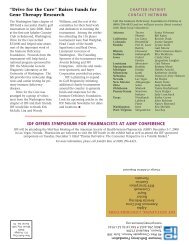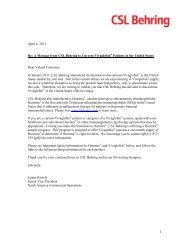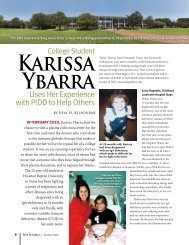IDF Patient & Family Handbook for Primary Immunodeficiency ... - IDFA
IDF Patient & Family Handbook for Primary Immunodeficiency ... - IDFA
IDF Patient & Family Handbook for Primary Immunodeficiency ... - IDFA
Create successful ePaper yourself
Turn your PDF publications into a flip-book with our unique Google optimized e-Paper software.
Inheritance<br />
73<br />
Types of Inheritance<br />
Many diseases are genetic in origin and are<br />
passed on in families. Most of the primary<br />
immunodeficiency diseases are inherited in one<br />
of two different modes of inheritance; X-linked<br />
recessive or autosomal recessive. Rarely, the<br />
inheritance is autosomal dominant. Laboratory<br />
studies can be helpful in establishing the possible<br />
role of genes or chromosomes in a particular<br />
primary immunodeficiency disease. In addition,<br />
family history in<strong>for</strong>mation may help to identify<br />
a particular pattern of inheritance, as can<br />
comparisons to other families with similar problems.<br />
Consult the appropriate handbook chapter or your<br />
physician to learn whether a particular immune<br />
deficiency disease is genetic, and if so, what <strong>for</strong>m<br />
of inheritance is involved.<br />
X-linked Recessive Inheritance<br />
One type of single gene disorder involves those<br />
genes located on the X chromosome. Since women<br />
have two X chromosomes, they usually do not have<br />
problems when a gene on one X chromosome<br />
does not work properly. This is because they have a<br />
second X chromosome that usually carries a normal<br />
gene and compensates <strong>for</strong> the abnormal gene<br />
on the affected X chromosome. Men have only<br />
one X chromosome, which is paired with their<br />
male-determining Y chromosome. The Y<br />
chromosome does not carry much active genetic<br />
in<strong>for</strong>mation. There<strong>for</strong>e, if there is an abnormal gene<br />
on the X chromosome, the paired Y chromosome<br />
has no normal gene to compensate <strong>for</strong> the<br />
abnormal gene on the affected X chromosome, and<br />
the boy (man) has the disorder. This special type of<br />
inheritance is called X-linked recessive.<br />
In this <strong>for</strong>m of inheritance, a family history of several<br />
affected males may be found. The disease is<br />
passed on from females (mothers) to males (sons).<br />
While the males are affected with the disease, the<br />
carrier females are generally asymptomatic and<br />
healthy even though they carry the gene <strong>for</strong> the<br />
disease because they carry a normal gene on the<br />
other X chromosome. The diagram in Figure 2<br />
illustrates how this kind of inheritance operates in<br />
the usual situation.<br />
X-linked agammaglobulinemia is used as the<br />
specific example. Parents in the situation shown<br />
in Figure 2 can have 4 different types of children<br />
with respect to X-linked agammaglobulinemia.<br />
CHAPTER 15; FIGURE 2<br />
X-linked Recessive Inheritance—Carrier Mother
















